2019 Science Highlights
Imaging a Supermassive Black Hole
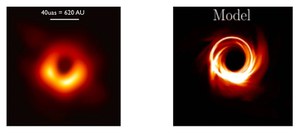 The direct imaging of a supermassive black hole (SMBH) event horizon at the heart of the galaxy Messier M87 by the Event Horizon Telescope (EHT) was an extraordinary scientific achievement, the culmination of years of effort by an international team, in collaboration with NRAO staff, to perform submillimeter Very Long Baseline Interferometry (VLBI) observations at the ultra-high angular resolution of 20 microarcseconds.
The direct imaging of a supermassive black hole (SMBH) event horizon at the heart of the galaxy Messier M87 by the Event Horizon Telescope (EHT) was an extraordinary scientific achievement, the culmination of years of effort by an international team, in collaboration with NRAO staff, to perform submillimeter Very Long Baseline Interferometry (VLBI) observations at the ultra-high angular resolution of 20 microarcseconds.
ALMA was vital to this research: without the ultra-sensitive phased ALMA, these observations would have been impossible. The ALMA phasing project was funded in-part through the ALMA development program.
A defining feature of the images of radio emission at the heart of galaxy M87 is an irregular but clear bright ring, whose size and shape agree closely with the expected lensed photon orbit of a 6.5 billion solar mass black hole. Soon after Einstein introduced general relativity, theorists derived the full analytic form of the photon orbit, and first simulated its lensed appearance in the 1970s. By the 2000s, it was possible to sketch the "shadow" formed in the image when synchrotron emission from an optically thin accretion flow is lensed in the black hole's gravity. During this time, observational evidence began to build for the existence of black holes at the centers of active galaxies, and in our own Milky Way. In particular, a steady progression in radio astronomy enabled VLBI observations at ever-shorter wavelengths, targeting SMBHs with the largest apparent event horizons: M87, and Sgr A* in the Galactic Center. The compact sizes of these two sources were confirmed by studies at 1.3mm, first exploiting baselines from Hawai'i to the mainland U.S., then with increased resolution on baselines to Spain and Chile.
Over the past decade, the EHT extended these first measurements of size to mount the more ambitious campaign of imaging the shadow itself. In April 2017, the EHT observed M87 on four days using an array of eight radio telescopes at six geographic locations: Arizona (USA), Chile, Hawaii (USA), Mexico, the South Pole, and Spain. Years of preparation and fortuitous planet-wide good weather yielded a multi-petabyte dataset. The results presented here, from observations through images to interpretation, issue from a team of instrument, algorithm, software, modeling, and theoretical experts, following a tremendous effort by a group of scientists that span all career stages, from undergraduates to senior members of the field. More than 200 members from 59 institutes in 20 countries contributed.
The final images emerged after a rigorous evaluation of traditional imaging algorithms and new techniques tailored to the EHT instrument – alongside many months of testing the imaging algorithms through the analysis of synthetic data sets.
The resultant image of the shadow confines the mass of M87 to within its photon orbit, providing the strongest case for the existence of SMBHs. These EHT observations are consistent with Doppler brightening of relativistically moving plasma close to the black hole lensed around the photon orbit. They strengthen the fundamental connection between active galactic nuclei and central engines powered by accreting black holes through an entirely new approach.
More than 200 members from 59 institutes in 20 countries and regions have devoted years to the effort, all unified by a common scientific vision. This historic result provides perhaps the ultimate verification of strong-field general relativity and signals the development of a new field of research in astronomy.
IMAGE: [Left] EHT 230 GHz image of the M87 black hole event horizon. [Right] Model for the General Relativistic shadow caused by the severe space-time bending around the Schwarzschild radius, seen as a bright ring with a dark center, indicating the radius of the orbits of the last photons able to escape the extreme gravitational field of the 6 x 109 M⊙ black hole (EHT Collaboration: Akiyama, Kazunori et al., 2019).
Publications
Focus on the First Event Horizon Telescope Results
Astrophysical Journal, 875, L1 (10 April 2019)
Event Horizon Telescope Collaboration: Akiyama, Kazunori (NRAO, Haystack Observatory, National Astronomical Observatory of Japan, Harvard University) et al., First M87 Event Horizon Telescope Results.
NRAO Press Release: Radio Astronomy and Black Holes
Precision Black Hole Masses
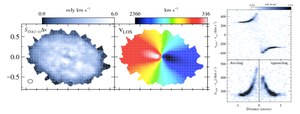 The authors present high resolution (0.1 arcsec ~ 15pc) ALMA imaging of the CO 2-1 emission of the dusty molecular disk surrounding the supermassive black hole (SMBH) in the massive elliptical galaxy, NGC3258 (d ~ 31 Mpc), probing well within the gravitational sphere of influence of the SMBH. These data reveal a quasi-Keplerian central increase in projected rotation speed rising from 280 km/sec at the disk's outer edge to >400 km/sec near the disk center. The authors construct dynamical models for the rotating disk and fit beam-smeared model CO line profiles directly to the ALMA data cube. These models incorporate flat and tilted-ring disks that provide a better fit of the mildly warped structure in NGC 3258, demonstrating that the exceptional angular resolution of the ALMA data makes it possible to infer the host galaxy's mass profile within r = 150 pc solely from the ALMA CO kinematics, without relying on optical or near-infrared imaging data to determine the stellar mass profile. The model therefore circumvents any uncertainty in the BH mass that would result from the substantial dust extinction in the galaxy's central region. The best model fit yields MBH = 2.249 x 109 M⊙, with a statistical model-fitting uncertainty of just 0.18%, and systematic uncertainties of 0.62% from various aspects of the model construction and 12% from uncertainty in the distance to NGC 3258. This observation demonstrates the full potential of ALMA for carrying out highly precise measurements of black holes masses in early-type galaxies containing circumnuclear gas disks.
The authors present high resolution (0.1 arcsec ~ 15pc) ALMA imaging of the CO 2-1 emission of the dusty molecular disk surrounding the supermassive black hole (SMBH) in the massive elliptical galaxy, NGC3258 (d ~ 31 Mpc), probing well within the gravitational sphere of influence of the SMBH. These data reveal a quasi-Keplerian central increase in projected rotation speed rising from 280 km/sec at the disk's outer edge to >400 km/sec near the disk center. The authors construct dynamical models for the rotating disk and fit beam-smeared model CO line profiles directly to the ALMA data cube. These models incorporate flat and tilted-ring disks that provide a better fit of the mildly warped structure in NGC 3258, demonstrating that the exceptional angular resolution of the ALMA data makes it possible to infer the host galaxy's mass profile within r = 150 pc solely from the ALMA CO kinematics, without relying on optical or near-infrared imaging data to determine the stellar mass profile. The model therefore circumvents any uncertainty in the BH mass that would result from the substantial dust extinction in the galaxy's central region. The best model fit yields MBH = 2.249 x 109 M⊙, with a statistical model-fitting uncertainty of just 0.18%, and systematic uncertainties of 0.62% from various aspects of the model construction and 12% from uncertainty in the distance to NGC 3258. This observation demonstrates the full potential of ALMA for carrying out highly precise measurements of black holes masses in early-type galaxies containing circumnuclear gas disks.
Image: [Left] CO 2-1 moment maps. [Right] CO 2-1 spectrum and PV diagram for NGC3258. (Boizelle et al. 2019ApJ...881...10B)
Publication: Benjamin D. Boizelle (Texas A&M, University of California, Irvine), et al., A Precision Measurement of the Mass of the Black Hole in NGC 3258 from High-resolution ALMA Observations of Its Circumnuclear Disk, Astrophysical Journal, 881, 10 (13 August 2019).
NRAO Press Release: ALMA Dives into Black Hole's 'Sphere of Influence'
A Rapidly Changing Jet Orientation
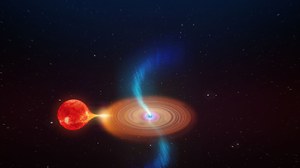 Powerful relativistic jets are one of the primary ways in which accreting black holes provide kinetic feedback to their surroundings. Jets launched from or redirected by the accretion flow that powers them are expected to be affected by the dynamics of the flow, which for accreting stellar-mass black holes has shown evidence for precession due to frame-dragging effects that occur when the black-hole spin axis is misaligned with the orbital plane of its companion star. Recent theoretical simulations have suggested that the jets can exert an additional torque on the accretion flow, although the interplay between the dynamics of the accretion flow and the launching of the jets is not yet understood. In this contribution, Miller-Jones et al. report a rapidly changing jet orientation—on a time scale of minutes to hours—in the black-hole X-ray binary V404 Cygni, detected with the Very Long Baseline Array during the peak of its 2015 outburst. The authors demonstrate that this changing jet orientation can be modelled as the Lense–Thirring precession of a vertically extended slim disk that arises from the super-Eddington accretion rate. These findings suggest that the dynamics of the precessing inner accretion disk could play a role in either directly launching or redirecting the jets within the inner few hundred gravitational radii. Similar dynamics should be expected in any strongly accreting black hole whose spin is misaligned with the inflowing gas, both affecting the observational characteristics of the jets and distributing the black-hole feedback more uniformly over the surrounding environment.
Powerful relativistic jets are one of the primary ways in which accreting black holes provide kinetic feedback to their surroundings. Jets launched from or redirected by the accretion flow that powers them are expected to be affected by the dynamics of the flow, which for accreting stellar-mass black holes has shown evidence for precession due to frame-dragging effects that occur when the black-hole spin axis is misaligned with the orbital plane of its companion star. Recent theoretical simulations have suggested that the jets can exert an additional torque on the accretion flow, although the interplay between the dynamics of the accretion flow and the launching of the jets is not yet understood. In this contribution, Miller-Jones et al. report a rapidly changing jet orientation—on a time scale of minutes to hours—in the black-hole X-ray binary V404 Cygni, detected with the Very Long Baseline Array during the peak of its 2015 outburst. The authors demonstrate that this changing jet orientation can be modelled as the Lense–Thirring precession of a vertically extended slim disk that arises from the super-Eddington accretion rate. These findings suggest that the dynamics of the precessing inner accretion disk could play a role in either directly launching or redirecting the jets within the inner few hundred gravitational radii. Similar dynamics should be expected in any strongly accreting black hole whose spin is misaligned with the inflowing gas, both affecting the observational characteristics of the jets and distributing the black-hole feedback more uniformly over the surrounding environment.
Image: Artist's concept, V404 Cygni. The binary star system consists of a normal star in orbit with a black hole. Material from the star falls towards the black hole and spirals inwards in an accretion disk, with powerful jets being launched from the inner regions close to the black hole. Credit: ICRAR
Publication: James C.A. Miller-Jones (International Centre for Radio Astronomy Research – Curtin University) et al., A Rapidly Changing Jet Orientation in the Stellar-mass Black-hole System V404 Cygni, Nature, 569, 374 (29 April 2019).
NRAO Press Release: Black Hole's Tug on Space Pulls Fast-Moving Jets in Rapid Wobble
Measuring the Hubble Constant Via Superluminal Motion
 The Hubble constant (H0) measures the current expansion rate of the Universe, and plays a fundamental role in cosmology. Enormous effort has been dedicated over the past decades to measure H0. Notably, Planck cosmic microwave background and the local Cepheid-supernovae distance ladder measurements determine H0 with a precision of ∼1% and ∼2% respectively. A 3σ level of discrepancy exists between the two measurements, for reasons that have yet to be understood
The Hubble constant (H0) measures the current expansion rate of the Universe, and plays a fundamental role in cosmology. Enormous effort has been dedicated over the past decades to measure H0. Notably, Planck cosmic microwave background and the local Cepheid-supernovae distance ladder measurements determine H0 with a precision of ∼1% and ∼2% respectively. A 3σ level of discrepancy exists between the two measurements, for reasons that have yet to be understood
Gravitational wave (GW) sources accompanied by electromagnetic (EM) counterparts offer an independent, “standard siren” measurement of H0, as demonstrated following the discovery of the neutron star merger, GW170817. This measurement does not assume a cosmological model and is independent of a cosmic distance ladder. The first joint analysis of the GW signal from GW170817 and its EM localization led to a measurement of H0 = 74+16−8 km/sec/Mpc.
In this analysis, the degeneracy in the GW signal between the source distance and the observing angle dominated the H0 measurement uncertainty. Recently, Mooley at al. (Nature 561, 355, (2018)) obtained tight constraints on the observing angle using high angular resolution imaging of the radio counterpart of GW170817 have been obtained. In this contribution, Hotokezaka et al. report an improved measurement H0 = 70.3+5.3−5.0 km/sec/Mpc by using these new radio observations, combined with the previous GW and EM data. The authors estimate that just 15 more GW170817-like events, having radio images and light curve data, will potentially resolve the tension between the cosmic microwave background and Cepheid-supernova measurements, as compared to 50-100 GW events without such data.
IMAGE: [Left] Proper motion of the VLBI components of GW170817 at 5 GHz over 155 days. [Right] Distance to the source versus rotation plane for the merger, from which the Hubble constant can be derived (K. Hotokezaka et al. 2019).
Publication: Hotokezaka, Kenta (Princeton University) et al., A Hubble Constant Measurement from Superluminal Motion of the Jet in GW170817, Nature Astronomy, 3, 940 (8 July 2019).
NRAO Press Release: New Method May Resolve Difficulty in Measuring Universe's Expansion
Star Formation in Luminous & Ultra-luminous Galaxies
 Linden et al. present the first results of a high-resolution Karl G. Jansky Very Large Array imaging survey of luminous and ultra-luminous infrared galaxies (U/LIRGs) in the Great Observatories All-sky LIRG Survey (GOALS). From a full sample of 68 galaxies, the authors selected 25 luminous infrared galaxies (LIRGs) that show resolved extended emission at sufficient sensitivity to image individual regions of star formation activity beyond the nucleus. Ranging from 10 pc to 1 kpc, the resolution was adequate to isolate numerous massive star forming regions across the galaxies, including those in tidal tails and filaments. With wideband radio continuum observations that sampled frequencies from 3 to 33 GHz, the authors made extinction-free measurements of the luminosities and spectral indices of 48 individual star-forming regions having deprojected galactocentric radii that lie outside the 13.2 μm core of the galaxy. The median 33 GHz thermal fraction and 3–33 GHz spectral index measured for these extranuclear regions is 65% ± 11% and –0.51 ± 0.13, respectively. These values are consistent with measurements made on matched spatial scales in normal star-forming galaxies, and suggests that these regions are more heavily dominated by thermal free–free emission relative to the centers of local U/LIRGs. The authors also find that the median star formation rate derived for these regions is ~1 M⊙/year, and when placed on the sub-galactic star-forming main sequence of galaxies, they are offset from their host galaxies' globally-averaged specific star formation rates. The authors conclude that while nuclear starburst activity drives LIRGs above the star-forming main sequence of galaxies, extranuclear star formation still proceeds in a more extreme fashion relative to what is seen in local spiral galaxies.
Linden et al. present the first results of a high-resolution Karl G. Jansky Very Large Array imaging survey of luminous and ultra-luminous infrared galaxies (U/LIRGs) in the Great Observatories All-sky LIRG Survey (GOALS). From a full sample of 68 galaxies, the authors selected 25 luminous infrared galaxies (LIRGs) that show resolved extended emission at sufficient sensitivity to image individual regions of star formation activity beyond the nucleus. Ranging from 10 pc to 1 kpc, the resolution was adequate to isolate numerous massive star forming regions across the galaxies, including those in tidal tails and filaments. With wideband radio continuum observations that sampled frequencies from 3 to 33 GHz, the authors made extinction-free measurements of the luminosities and spectral indices of 48 individual star-forming regions having deprojected galactocentric radii that lie outside the 13.2 μm core of the galaxy. The median 33 GHz thermal fraction and 3–33 GHz spectral index measured for these extranuclear regions is 65% ± 11% and –0.51 ± 0.13, respectively. These values are consistent with measurements made on matched spatial scales in normal star-forming galaxies, and suggests that these regions are more heavily dominated by thermal free–free emission relative to the centers of local U/LIRGs. The authors also find that the median star formation rate derived for these regions is ~1 M⊙/year, and when placed on the sub-galactic star-forming main sequence of galaxies, they are offset from their host galaxies' globally-averaged specific star formation rates. The authors conclude that while nuclear starburst activity drives LIRGs above the star-forming main sequence of galaxies, extranuclear star formation still proceeds in a more extreme fashion relative to what is seen in local spiral galaxies.
Image: Multifrequency imaging of a typical galaxy, in the GOALS VLA survey, NGC 3110 at a distance of 70 Mpc (Linden et al. 2019).
Publication: S.T. Linden (Univ of Virginia) et al., A Very Large Array Survey of Luminous Extranuclear Star-forming Regions in Luminous Infrared Galaxies in GOALS, Astrophysical Journal, 881, 70 (13 August 2019).
A High-resolution, 3D Neutral Hydrogen Survey
 The COSMOS H I Large Extragalactic Survey (CHILES) Very Large Array (VLA) deep field is the first high-resolution, three-dimensional survey of neutral hydrogen (HI) 21cm emission over a substantial cosmic volume. In this initial contribution, Hess et al. present a study of 16 neutral hydrogen (HI)-detected galaxies found in 178 hours of Very Large Array observations from Epoch 1 of the COSMOS H I Large Extragalactic Survey (CHILES). They focus on two redshift ranges between 0.108 ≤ z ≤ 0.127 and 0.162 ≤ z ≤ 0.183 which are among the worst affected by radio frequency interference (RFI). While this represents only 10% of the total frequency coverage and 18% of the total expected time on source compared to what will be the full CHILES survey, they demonstrate that their data reduction pipeline recovers high-quality data even in regions severely impacted by RFI. They also report on our in-depth testing of an automated spectral line source finder to produce H I total intensity maps which we present side-by-side with significance maps to evaluate the reliability of the morphology recovered by the source finder. The team recommends that this become a common place manner of presenting data from upcoming H Isurveys of resolved objects. They use the COSMOS 20k group catalogue and extract the filamentary structure using the topological DisPerSE algorithm to evaluate the H I morphology in the context of both local and large-scale environments and we discuss the shortcomings of both methods. Many of the detections show disturbed H I morphologies suggesting they have undergone a recent interaction which is not evident from deep optical imaging alone. Overall, the sample showcases the broad range of ways in which galaxies interact with their environment. This is a first look at the population of galaxies and their local and large-scale environments observed in H I by CHILES at redshifts beyond the z = 0.1 Universe. These VLA observations provide crucial insight into the physics of the gaseous evolution of the neutral atomic gas in galaxies, and guidance for future deeper surveys with next generation radio arrays.
The COSMOS H I Large Extragalactic Survey (CHILES) Very Large Array (VLA) deep field is the first high-resolution, three-dimensional survey of neutral hydrogen (HI) 21cm emission over a substantial cosmic volume. In this initial contribution, Hess et al. present a study of 16 neutral hydrogen (HI)-detected galaxies found in 178 hours of Very Large Array observations from Epoch 1 of the COSMOS H I Large Extragalactic Survey (CHILES). They focus on two redshift ranges between 0.108 ≤ z ≤ 0.127 and 0.162 ≤ z ≤ 0.183 which are among the worst affected by radio frequency interference (RFI). While this represents only 10% of the total frequency coverage and 18% of the total expected time on source compared to what will be the full CHILES survey, they demonstrate that their data reduction pipeline recovers high-quality data even in regions severely impacted by RFI. They also report on our in-depth testing of an automated spectral line source finder to produce H I total intensity maps which we present side-by-side with significance maps to evaluate the reliability of the morphology recovered by the source finder. The team recommends that this become a common place manner of presenting data from upcoming H Isurveys of resolved objects. They use the COSMOS 20k group catalogue and extract the filamentary structure using the topological DisPerSE algorithm to evaluate the H I morphology in the context of both local and large-scale environments and we discuss the shortcomings of both methods. Many of the detections show disturbed H I morphologies suggesting they have undergone a recent interaction which is not evident from deep optical imaging alone. Overall, the sample showcases the broad range of ways in which galaxies interact with their environment. This is a first look at the population of galaxies and their local and large-scale environments observed in H I by CHILES at redshifts beyond the z = 0.1 Universe. These VLA observations provide crucial insight into the physics of the gaseous evolution of the neutral atomic gas in galaxies, and guidance for future deeper surveys with next generation radio arrays.
Image: CHILES VLA image of an HI group at z = 0.12 (Hess et al., 2018).
Publication: Kelley M. Hess (Netherlands Institute for Radio Astronomy) et al., CHILES: HI Morphology and Galaxy Environment at z=0.12 and z=0.17, Monthly Notices of the Royal Astronomical Society, 484, 2234 (20 December 2018).
Probing the Torus of an Active Galactic Nucleus
 An active galactic nucleus (AGN) corresponds to the process of prodigious energy production by gas in-fall onto a supermassive black hole. In this work, Carilli et al. present the first direct imaging of what may be the thick torus in the AGN of the archetype powerful radio galaxy Cygnus A, using the Jansky Very Large Array at 18–48 GHz, with a resolution down to 45 milli-arcseconds. Such a torus has long been a key component of AGN models, but direct imaging on the relevant physical scales in sources of extreme (quasar-like) luminosities, remains scarce. An elongated structure, perpendicular to the radio jets and centered on the core, is well resolved, with a full length of 0.48 arcsec (528 pc), and a full width of 0.26 arcsec (286 pc). The radio emission spectrum is consistent with optically thin free–free emission. The authors present a toy model of a flaring torus, with a half-opening angle for the poloidal region of 62°. The radio jets are oriented along the poles. The observations require a clumpy gas distribution, with the free–free emission dominated by clumps with densities ≥ 4000 cm−3.
An active galactic nucleus (AGN) corresponds to the process of prodigious energy production by gas in-fall onto a supermassive black hole. In this work, Carilli et al. present the first direct imaging of what may be the thick torus in the AGN of the archetype powerful radio galaxy Cygnus A, using the Jansky Very Large Array at 18–48 GHz, with a resolution down to 45 milli-arcseconds. Such a torus has long been a key component of AGN models, but direct imaging on the relevant physical scales in sources of extreme (quasar-like) luminosities, remains scarce. An elongated structure, perpendicular to the radio jets and centered on the core, is well resolved, with a full length of 0.48 arcsec (528 pc), and a full width of 0.26 arcsec (286 pc). The radio emission spectrum is consistent with optically thin free–free emission. The authors present a toy model of a flaring torus, with a half-opening angle for the poloidal region of 62°. The radio jets are oriented along the poles. The observations require a clumpy gas distribution, with the free–free emission dominated by clumps with densities ≥ 4000 cm−3.
Image: VLA image of the central region of the powerful radio galaxy Cygnus A, showing the doughnut-shaped torus surrounding the black hole and accretion disk (C.L. Carilli et al.)
Publication: C.L. Carilli (National Radio Astronomy Observatory) et al., Imaging the Active Galactic Nucleus Torus in Cygni A, Astrophysical Journal Letters, 874, L32 (5 April 2019).
NRAO Press Release: VLA Makes First Direct Image of Key Feature of Powerful Radio Galaxies
A Cannonball Pulsar
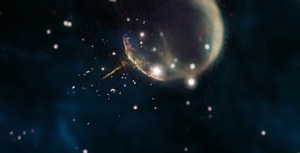 English et al. conducted imaging with the Karl G. Jansky Very Large Array and performed a Fermi timing analysis of the 115 millisecond γ-ray and radio pulsar PSR J0002+6216, which is at a distance of ~ 6,500 light-years, and was discovered in 2017 by the Einstein@Home citizen-science project. Their research demonstrates that the pulsar lies at the apex of a narrowly collimated, cometary-like, seven arcminute tail of nonthermal radio emission, which they identify as a bow-shock pulsar wind nebula. The tail of the nebula points back toward the geometric center of the supernova remnant CTB 1 (G116.9+0.2) 28 arcminutes away, at a position angle θ μ = 113°. They measured a proper motion with 2.9σ significance from their Fermi timing analysis giving μ = 115 ± 33 milliarcseconds/year and θ μ = 121° ± 13°, corresponding to a large transverse pulsar velocity of 1100 km/sec at a distance of 2 kpc. This proper motion is of the right magnitude and direction to support the claim that PSR J0002+6216 was born from the same supernova that produced CTB 1. This research explores the implications of this for pulsar birth periods, asymmetric supernova explosions, and mechanisms for pulsar natal kick velocities.
English et al. conducted imaging with the Karl G. Jansky Very Large Array and performed a Fermi timing analysis of the 115 millisecond γ-ray and radio pulsar PSR J0002+6216, which is at a distance of ~ 6,500 light-years, and was discovered in 2017 by the Einstein@Home citizen-science project. Their research demonstrates that the pulsar lies at the apex of a narrowly collimated, cometary-like, seven arcminute tail of nonthermal radio emission, which they identify as a bow-shock pulsar wind nebula. The tail of the nebula points back toward the geometric center of the supernova remnant CTB 1 (G116.9+0.2) 28 arcminutes away, at a position angle θ μ = 113°. They measured a proper motion with 2.9σ significance from their Fermi timing analysis giving μ = 115 ± 33 milliarcseconds/year and θ μ = 121° ± 13°, corresponding to a large transverse pulsar velocity of 1100 km/sec at a distance of 2 kpc. This proper motion is of the right magnitude and direction to support the claim that PSR J0002+6216 was born from the same supernova that produced CTB 1. This research explores the implications of this for pulsar birth periods, asymmetric supernova explosions, and mechanisms for pulsar natal kick velocities.
Image Credit: Jayanne English, University of Manitoba; F. Schinzel et al.; NRAO/AUI/NSF; DRAO/Canadian Galactic Plane Survey; and NASA/IRAS.
Publication: F. K. Schinzel (NRAO) et al., The Tail of PSR J0002+6216 and the Supernova Remnant CTB 1, Astrophysical Journal Letters, 876, L17 (3 May 2019).
NRAO Press Release: Astronomers Find "Cannonball Pulsar" Speeding Through Space
Circumplanetary Disk Detection
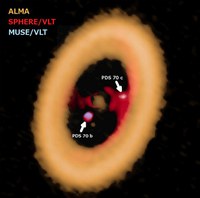 The combination of high-resolution ALMA dust imaging and Very Large Telescope (VLT) imaging of the ionized gas in a protoplanetary system, PDS 70, has shown evidence for accretion onto planets themselves, for the first time. PDS 70 is a planetary system forming around a 0.8 M⊙T Tauri star at a distance of 113 pc.
The combination of high-resolution ALMA dust imaging and Very Large Telescope (VLT) imaging of the ionized gas in a protoplanetary system, PDS 70, has shown evidence for accretion onto planets themselves, for the first time. PDS 70 is a planetary system forming around a 0.8 M⊙T Tauri star at a distance of 113 pc.
In this work, Isella et al. describe the discovery of a spatially unresolved source of submillimeter continuum emission (λ = 855 μm) associated with a young planet, PDS 70c, recently detected in Hα emission around the 5 Myr old T Tauri star, PDS 70. The authors interpret the emission as originating from a dusty circumplanetary disk with a dust mass between 2 x 10-3 M⊕ and 4.2 x 10-3 M⊕. Assuming a standard gas-to-dust ratio of 100, the ratio between the total mass of the circumplanetary disk and the mass of the central planet would be between 10−4 and 10−5. The authors also report the discovery of another compact continuum source 0.074 ± 0.013 arcsec southwest of a second known planet in this system, PDS 70b, that was previously detected in near-infrared images. The authors speculate that the latter source might trace dust orbiting in proximity of the planet, but more sensitive observations are required to unveil its nature.
VLT imaging of Ha emission has revealed two forming planets, present in a gap in the dust disk, at distances of 23 and 35 AU from the star, with masses of 4 and 12 MJ. ALMA 350 GHz images down to 0.05 arcsecond resolution show dust emission from the planets themselves, indicating circum-planetary disks associated with the forming planets. These mini-dust disks will eventually coalesce to form moons and dust rings, similar to those seen around the giant planets in the Solar System.
Image: ALMA 350 GHz and VLT images of the protoplanetary disk, PDS 70 (Isella et al.)
Publication: Andrea Isella (Rice University) et al., Continuum Submillimeter Emission Associated with Candidate Protoplanets, Astrophysical Journal Letters, 879, L25 (10 July 2019).
NRAO Press Release: 'Moon-forming' Circumplanetary Disk Discovered in Distant Star System
The Solar System at Millimeter Wavelengths: Jupiter
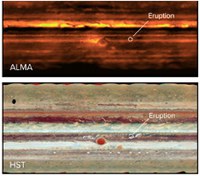 Imke det Pater et al. obtained the first maps of Jupiter at 1–3 mm wavelength with ALMA in early January 2017, just days after an energetic eruption in the southern hemisphere was reported by the amateur community, and ~2-3 months after the detection of similarly energetic eruptions in the northern hemisphere. Their ALMA observations probe below the ammonia cloud deck and show that the erupting plumes in the South Equatorial Belt bring up ammonia gas from the deep atmosphere. While models of plume eruptions that are triggered at the water condensation level explain data taken at uv–visible and mid-infrared wavelengths, these ALMA observations provide a crucial, hitherto missing, link in the moist convection theory by showing that ammonia gas from the deep atmosphere is indeed brought up in these plumes. Contemporaneous Hubble Space Telescope data show that the plumes reach altitudes as high as the tropopause. The authors suggest that the northern hemisphere plumes also rise up well above the ammonia cloud deck and that descending air may dry the neighboring belts even more than in quiescent times.
Imke det Pater et al. obtained the first maps of Jupiter at 1–3 mm wavelength with ALMA in early January 2017, just days after an energetic eruption in the southern hemisphere was reported by the amateur community, and ~2-3 months after the detection of similarly energetic eruptions in the northern hemisphere. Their ALMA observations probe below the ammonia cloud deck and show that the erupting plumes in the South Equatorial Belt bring up ammonia gas from the deep atmosphere. While models of plume eruptions that are triggered at the water condensation level explain data taken at uv–visible and mid-infrared wavelengths, these ALMA observations provide a crucial, hitherto missing, link in the moist convection theory by showing that ammonia gas from the deep atmosphere is indeed brought up in these plumes. Contemporaneous Hubble Space Telescope data show that the plumes reach altitudes as high as the tropopause. The authors suggest that the northern hemisphere plumes also rise up well above the ammonia cloud deck and that descending air may dry the neighboring belts even more than in quiescent times.
Image: Ammonia in the Jovian atmosphere (de Pater et al.).
Publication: Imke de Pater (University of California, Berkeley) et al., First ALMA Millimeter-wavelength Maps of Jupiter with a Multiwavelength Study of Convection, Astronomical Journal, 158, 139 (October 2019).
NRAO Press Release: Radio Jupiter: Seeing Giant Planet in a New Light
The Solar System at Millimeter Wavelengths: Uranus
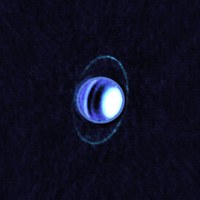 The narrow main rings of Uranus are composed of almost exclusively centimeter- to meter-sized particles, with a very small or nonexistent dust component; however, the filling factor, composition, thickness, mass, and detailed particle size distribution of these rings remain poorly constrained. Using millimeter (1.3–3.1 mm) imaging with ALMA and mid-infrared (18.7 μm) imaging from the Very Large Telescope, Molter et al. observed the thermal component of the Uranian ring system for the first time. The ε ring is detected strongly and can be seen by eye in the images; the other main rings are visible in a radial (azimuthally averaged) profile at millimeter wavelengths. A simple thermal model similar to the Near-Earth Asteroid Thermal Model is applied to the ε ring to determine a ring particle temperature of 77.3 ± 1.8 K. The observed temperature is higher than expected for fast-rotating ring particles viewed at our observing geometry, meaning that the data favor a model in which the thermal inertia of the ring particles is low and/or their rotation rate is slow. The ε ring displays a factor of 2–3 brightness difference between periapsis and apoapsis, with 49.1% ± 2.2% of sightlines through the ring striking a particle. These observations are consistent with optical and near-infrared reflected light observations, confirming the hypothesis that micron-sized dust is not present in the ring system.
The narrow main rings of Uranus are composed of almost exclusively centimeter- to meter-sized particles, with a very small or nonexistent dust component; however, the filling factor, composition, thickness, mass, and detailed particle size distribution of these rings remain poorly constrained. Using millimeter (1.3–3.1 mm) imaging with ALMA and mid-infrared (18.7 μm) imaging from the Very Large Telescope, Molter et al. observed the thermal component of the Uranian ring system for the first time. The ε ring is detected strongly and can be seen by eye in the images; the other main rings are visible in a radial (azimuthally averaged) profile at millimeter wavelengths. A simple thermal model similar to the Near-Earth Asteroid Thermal Model is applied to the ε ring to determine a ring particle temperature of 77.3 ± 1.8 K. The observed temperature is higher than expected for fast-rotating ring particles viewed at our observing geometry, meaning that the data favor a model in which the thermal inertia of the ring particles is low and/or their rotation rate is slow. The ε ring displays a factor of 2–3 brightness difference between periapsis and apoapsis, with 49.1% ± 2.2% of sightlines through the ring striking a particle. These observations are consistent with optical and near-infrared reflected light observations, confirming the hypothesis that micron-sized dust is not present in the ring system.
Image: A 250 GHz image of Uranus and its rings (Molter et al.).
Publication: Edward M. Molter (University of California, Berkeley) et al., Thermal Emission from the Uranian Ring System, Astronomical Journal, 158, 47 (July 2019).
NRAO Press Release: Planetary Rings of Uranus 'Glow' in Cold Light




Connect with NRAO